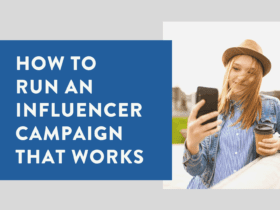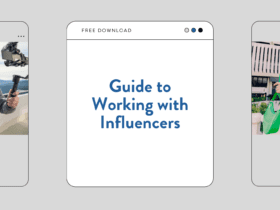Consider yourself influenced!
Influencer marketing is a vast industry worldwide, and it’s not going anywhere anytime soon.
As the number of active users on social media increases, getting reach on organic posts is becoming harder and harder.
Businesses are turning towards content creators to help drive their brand’s message. It sounds simple enough, right?
However, not all social influencers are created equal. Selecting the right influencer for your brand will expose you to several potential new customers.
TLDR; everything to know now
Let’s look at how to approach influencer marketing in 2024.
What is social influencer marketing?
Influencer marketing is a type of social media marketing. It involves a brand paying a person with a highly engaged social media audience (an influencer) to endorse their product, service or campaign on social media.
Below is an example of a paid collaboration between a brand, Marks and Spencer, and a food influencer, @emthenutritionist.
What makes influencers influential?
Influencer marketing is nothing new; it is the modern-day celebrity endorsement. However, many influencers are not celebrities or household names; many are social media content creators who have gathered a niche and loyal following on social media.
They have built relationships with followers and wield influence through regular posting. Businesses work with influencers to tap into that credibility and drive sales.
Compared to celebrities, influencers are relatable, uncensored and unscripted.
Why work with social influencers?
- Utilises the trust, authenticity and credibility influencers have with their followers.
- Improves brand awareness; the more people talk about your brand, the better!
- It helps enrich your content strategy, as you can repurpose it across your social media channels.
- Your brand and messaging reach your desired target audience and can increase your social following.
- Unlike traditional advertising campaigns, influencer marketing is a quick and cost-effective way to reach an audience.
- Can increase website traffic and drive sales.
Are all influencers the same?
There are subcategories of influencers, depending on how many followers they have.
Nano-influencers
A nano-influencer has up to 10K followers but has considerable influence and a narrow niche. The content a nano-influencer shares on their social media channels is typically hyper-authentic and personalised for their audience.
Micro-influencers
These influencers have 10K – 100K followers. They are known to have an intimate connection with their followers and are more cost-effective than more prominent influencers while still reaching many people.
Mid-range-influencers
This group has an audience of between 100K and 500K followers. Brands can expect high reach rates, but engagement is likely lower.
Mega/macro-influencers:
This category includes celebrities or anyone with over 500K followers. They are highly active on social media and can reach many people – although a BIG budget is required to work with these influencers.

Types of influencers to choose from
Influencers differ depending on how many followers they have, but their niche also categorises them. Here are the primary industries and niches to pick from.
Travel influencers
Travel influencers showcase the destinations they travel to and usually collaborate with airlines, accommodation providers, and PR companies representing those destinations.
For example, a PR rep from the Cocos Keeling Islands can invite a travel influencer to visit the islands and show off what to do.
Lifestyle influencers
Lifestyle influencers have a broader scope, but they generally post about their daily outfits, what they get up to each day (“day in the life” videos), how they exercise, and where they travel. Other niches under this category include mental health, life at university and what it’s like living abroad.
Food & cooking influencers
Under food influencers, there are two subcategories – those who go to restaurants and take photos of their food to promote that business or the cooks & chefs who share their recipes. Sometimes, these two interests overlap.
Family & parenting influencers
These influencers share the ins and outs of parenting, promote the clothes and products they buy for their children, and show the destinations they take their kids.
Beauty influencers
Beauty influencers will share their favourite beauty and makeup products and usually create tutorial videos.
Fashion influencers
Fashion influencers share their daily outfits, where to find great sales on clothes, the latest fashion trends and tips on styling clothes.
Health, fitness and wellness influencers
Health influencers share workout routines, healthy recipes, sleep routines and mental health tips to their audience.
Tools to help find influencers
Want to find an influencer but need help figuring out where to start? Luckily, some apps and websites can help analyse influencers and their performance, and they can even break down the niche markets they are connecting with.
Below is a quick summary of platforms that provide value for subscriptions.
HyperAuditor
HyperAuditor ranks influencers based on their quality of followers and authentic engagement, eliminating fake followers and likes. This website will be able to provide the following information:
- Influencer’s current ranking based on custom filters
- Their followers
- The country of their audience
- Percentage of authentic engagement
- The main topics that they post about
Upfluence
Upfluence is a well-rounded tool that not only can analyse influencers with a complete set of capabilities to help narrow your search but also can manage and streamline campaigns and can also:
- Show statistics in real-time
- Offers a Chrome plugin
- Is compatible with profiles on all major social media platforms (Instagram, Facebook, Youtube, Pinterest)
- Campaign management
- Team collaborations
- Live capture, which allows you to turn your visitors & customers into ambassadors
Influence
Influence helps you find and contact the best influencers in your local area. It also identifies:
- The number of followers
- Engagement rate,
- Cost of posts.
Questions to ask influencers before working with them
Before jumping into a collaboration, there are a few things you need to know first.
It’s essential to find out:
- Who their target audience is – would their followers care about your product or service?
- What content they provide – some influencers are big on Reels, while some prefer carousels.
- What their engagement rate is – while some influencers have a large following, this doesn’t always equate to a high engagement rate.
- When they deliver the content – have an honest conversation about timelines so you both go in with the exact expectations
- What their rates are – the cost of an influencer might be a lot more than you expect, so it’s best to be fully prepared and not go in blind!
How to calculate the ROI of influencer marketing campaigns
Whilst there may not be a simple nor a definitive formula in an industry that is constantly changing, there are ways to track your return on investment (ROI).
Here are some things to keep in mind.
Be clear about campaign goals.
Here are some common influencer marketing goals for marketers:
- Increase brand awareness
- Reach new/ target audience
- Improve brand advocacy
- Increase sales
- Manage brand reputation
Define metrics to measure campaign performance
It’s important to be realistic and set achievable targets for yourself.
Metrics to choose from include, but are not limited to:
- Engagement rate
- Clicks
- Impressions
- Conversions
- Reach
Use an influencer tracking platform
There are a few ways to track the performance of influencer campaigns:
- Grin – has a comprehensive list of KPIs to measure your campaign performance.
- NeoReach – this platform has a tracking and reporting feature allowing you to monitor real-time performance.
Influencer marketing vs traditional marketing?
Influencer marketing serves the same purpose as traditional advertising (TV, radio, billboards, magazines, newspapers) to drive brand awareness and create leads.
In 2024, to have a successful marketing campaign, brands need to combine the two and thrive harmoniously.
Traditional media effectively reaches a broader consumer audience, whereas influencer marketing is more niche and organic, as the audience has a vested interest in the influencer.
As ad blockers increase in popularity and Gen Z moves away from mass media, there is a versatility and budget that comes with influencer marketing.
Key things to remember for influencer marketing
Here are a few final things to remember before collaborating with an influencer.
Don’t make your posts advertisements
This is very important to remember. You are not making an infomercial!
You’re not trying to push a product down people’s throats. Instead, you want your influencer’s personal vibe to be injected into your campaign.
After all, the purpose is to use your influencer’s credibility, so your content needs to show that organically.
Allow your Influencers some creative control
Most influencers have built a loyal following by being real and showing their unique personality to their followers. The last thing you want to do as a brand is micro-manage your influencer when they’re creating content for your campaign.
We know it’s hard to hand over the reins sometimes, but spending time researching the right influencer and discussing everyone’s expectations before a campaign begins will put your mind at ease.
If you’re thinking of dipping your toes into the influencer marketing pool, we’ve compiled a handy template to help you start working with influencers.
Our template is a fantastic place to start. Not only will it help you start to understand how influencers might be able to help your brand reach new customers, but it will also help you understand whether or not influencer marketing is actually right for you.
Download your free influencer marketing template now and discover how working with influencers can help your business make more meaningful connections.









LET’S CONNECT